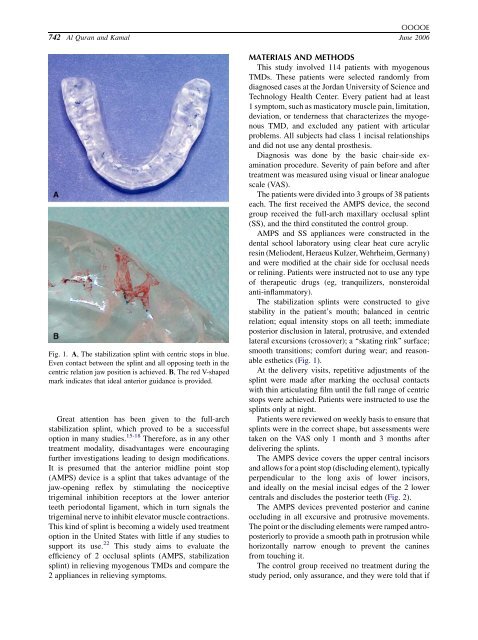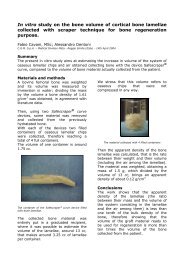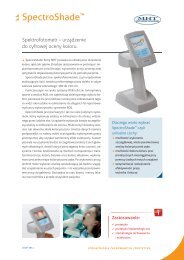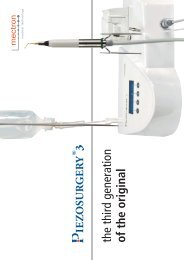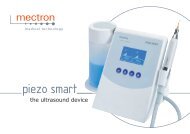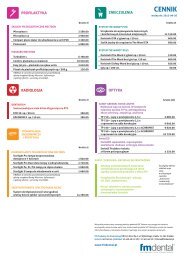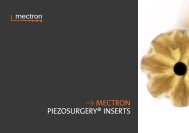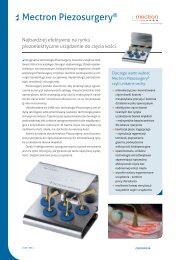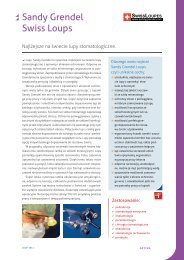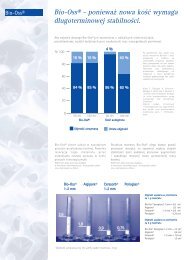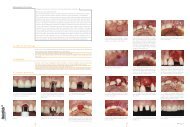Anterior midline point stop device (AMPS) in the treatment of ...
Anterior midline point stop device (AMPS) in the treatment of ...
Anterior midline point stop device (AMPS) in the treatment of ...
Create successful ePaper yourself
Turn your PDF publications into a flip-book with our unique Google optimized e-Paper software.
OOOOE<br />
742 Al Quran and Kamal June 2006<br />
Fig. 1. A, The stabilization spl<strong>in</strong>t with centric <strong>stop</strong>s <strong>in</strong> blue.<br />
Even contact between <strong>the</strong> spl<strong>in</strong>t and all oppos<strong>in</strong>g teeth <strong>in</strong> <strong>the</strong><br />
centric relation jaw position is achieved. B, The red V-shaped<br />
mark <strong>in</strong>dicates that ideal anterior guidance is provided.<br />
Great attention has been given to <strong>the</strong> full-arch<br />
stabilization spl<strong>in</strong>t, which proved to be a successful<br />
option <strong>in</strong> many studies. 15-18 Therefore, as <strong>in</strong> any o<strong>the</strong>r<br />
<strong>treatment</strong> modality, disadvantages were encourag<strong>in</strong>g<br />
fur<strong>the</strong>r <strong>in</strong>vestigations lead<strong>in</strong>g to design modifications.<br />
It is presumed that <strong>the</strong> anterior <strong>midl<strong>in</strong>e</strong> <strong>po<strong>in</strong>t</strong> <strong>stop</strong><br />
(<strong>AMPS</strong>) <strong>device</strong> is a spl<strong>in</strong>t that takes advantage <strong>of</strong> <strong>the</strong><br />
jaw-open<strong>in</strong>g reflex by stimulat<strong>in</strong>g <strong>the</strong> nociceptive<br />
trigem<strong>in</strong>al <strong>in</strong>hibition receptors at <strong>the</strong> lower anterior<br />
teeth periodontal ligament, which <strong>in</strong> turn signals <strong>the</strong><br />
trigem<strong>in</strong>al nerve to <strong>in</strong>hibit elevator muscle contractions.<br />
This k<strong>in</strong>d <strong>of</strong> spl<strong>in</strong>t is becom<strong>in</strong>g a widely used <strong>treatment</strong><br />
option <strong>in</strong> <strong>the</strong> United States with little if any studies to<br />
support its use. 22 This study aims to evaluate <strong>the</strong><br />
efficiency <strong>of</strong> 2 occlusal spl<strong>in</strong>ts (<strong>AMPS</strong>, stabilization<br />
spl<strong>in</strong>t) <strong>in</strong> reliev<strong>in</strong>g myogenous TMDs and compare <strong>the</strong><br />
2 appliances <strong>in</strong> reliev<strong>in</strong>g symptoms.<br />
MATERIALS AND METHODS<br />
This study <strong>in</strong>volved 114 patients with myogenous<br />
TMDs. These patients were selected randomly from<br />
diagnosed cases at <strong>the</strong> Jordan University <strong>of</strong> Science and<br />
Technology Health Center. Every patient had at least<br />
1 symptom, such as masticatory muscle pa<strong>in</strong>, limitation,<br />
deviation, or tenderness that characterizes <strong>the</strong> myogenous<br />
TMD, and excluded any patient with articular<br />
problems. All subjects had class 1 <strong>in</strong>cisal relationships<br />
and did not use any dental pros<strong>the</strong>sis.<br />
Diagnosis was done by <strong>the</strong> basic chair-side exam<strong>in</strong>ation<br />
procedure. Severity <strong>of</strong> pa<strong>in</strong> before and after<br />
<strong>treatment</strong> was measured us<strong>in</strong>g visual or l<strong>in</strong>ear analogue<br />
scale (VAS).<br />
The patients were divided <strong>in</strong>to 3 groups <strong>of</strong> 38 patients<br />
each. The first received <strong>the</strong> <strong>AMPS</strong> <strong>device</strong>, <strong>the</strong> second<br />
group received <strong>the</strong> full-arch maxillary occlusal spl<strong>in</strong>t<br />
(SS), and <strong>the</strong> third constituted <strong>the</strong> control group.<br />
<strong>AMPS</strong> and SS appliances were constructed <strong>in</strong> <strong>the</strong><br />
dental school laboratory us<strong>in</strong>g clear heat cure acrylic<br />
res<strong>in</strong> (Meliodent, Heraeus Kulzer, Wehrheim, Germany)<br />
and were modified at <strong>the</strong> chair side for occlusal needs<br />
or rel<strong>in</strong><strong>in</strong>g. Patients were <strong>in</strong>structed not to use any type<br />
<strong>of</strong> <strong>the</strong>rapeutic drugs (eg, tranquilizers, nonsteroidal<br />
anti-<strong>in</strong>flammatory).<br />
The stabilization spl<strong>in</strong>ts were constructed to give<br />
stability <strong>in</strong> <strong>the</strong> patient’s mouth; balanced <strong>in</strong> centric<br />
relation; equal <strong>in</strong>tensity <strong>stop</strong>s on all teeth; immediate<br />
posterior disclusion <strong>in</strong> lateral, protrusive, and extended<br />
lateral excursions (crossover); a ‘‘skat<strong>in</strong>g r<strong>in</strong>k’’ surface;<br />
smooth transitions; comfort dur<strong>in</strong>g wear; and reasonable<br />
es<strong>the</strong>tics (Fig. 1).<br />
At <strong>the</strong> delivery visits, repetitive adjustments <strong>of</strong> <strong>the</strong><br />
spl<strong>in</strong>t were made after mark<strong>in</strong>g <strong>the</strong> occlusal contacts<br />
with th<strong>in</strong> articulat<strong>in</strong>g film until <strong>the</strong> full range <strong>of</strong> centric<br />
<strong>stop</strong>s were achieved. Patients were <strong>in</strong>structed to use <strong>the</strong><br />
spl<strong>in</strong>ts only at night.<br />
Patients were reviewed on weekly basis to ensure that<br />
spl<strong>in</strong>ts were <strong>in</strong> <strong>the</strong> correct shape, but assessments were<br />
taken on <strong>the</strong> VAS only 1 month and 3 months after<br />
deliver<strong>in</strong>g <strong>the</strong> spl<strong>in</strong>ts.<br />
The <strong>AMPS</strong> <strong>device</strong> covers <strong>the</strong> upper central <strong>in</strong>cisors<br />
and allows for a <strong>po<strong>in</strong>t</strong> <strong>stop</strong> (disclud<strong>in</strong>g element), typically<br />
perpendicular to <strong>the</strong> long axis <strong>of</strong> lower <strong>in</strong>cisors,<br />
and ideally on <strong>the</strong> mesial <strong>in</strong>cisal edges <strong>of</strong> <strong>the</strong> 2 lower<br />
centrals and discludes <strong>the</strong> posterior teeth (Fig. 2).<br />
The <strong>AMPS</strong> <strong>device</strong>s prevented posterior and can<strong>in</strong>e<br />
occlud<strong>in</strong>g <strong>in</strong> all excursive and protrusive movements.<br />
The <strong>po<strong>in</strong>t</strong> or <strong>the</strong> disclud<strong>in</strong>g elements were ramped antroposteriorly<br />
to provide a smooth path <strong>in</strong> protrusion while<br />
horizontally narrow enough to prevent <strong>the</strong> can<strong>in</strong>es<br />
from touch<strong>in</strong>g it.<br />
The control group received no <strong>treatment</strong> dur<strong>in</strong>g <strong>the</strong><br />
study period, only assurance, and <strong>the</strong>y were told that if


